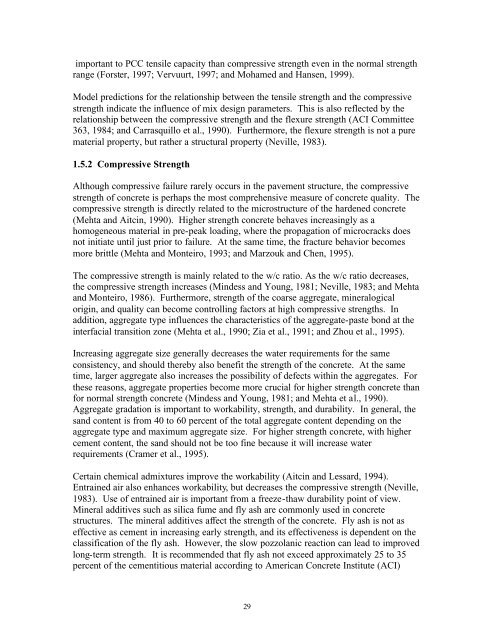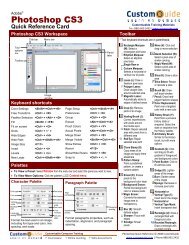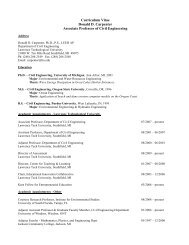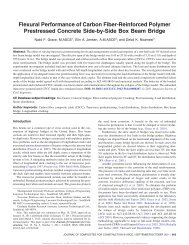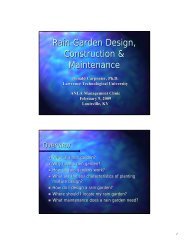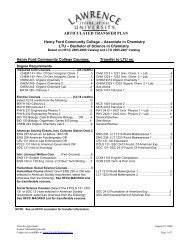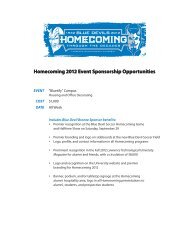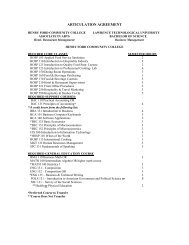The Effects of Higher Strength and Associated Concrete Properties ...
The Effects of Higher Strength and Associated Concrete Properties ...
The Effects of Higher Strength and Associated Concrete Properties ...
Create successful ePaper yourself
Turn your PDF publications into a flip-book with our unique Google optimized e-Paper software.
important to PCC tensile capacity than compressive strength even in the normal strength<br />
range (Forster, 1997; Vervuurt, 1997; <strong>and</strong> Mohamed <strong>and</strong> Hansen, 1999).<br />
Model predictions for the relationship between the tensile strength <strong>and</strong> the compressive<br />
strength indicate the influence <strong>of</strong> mix design parameters. This is also reflected by the<br />
relationship between the compressive strength <strong>and</strong> the flexure strength (ACI Committee<br />
363, 1984; <strong>and</strong> Carrasquillo et al., 1990). Furthermore, the flexure strength is not a pure<br />
material property, but rather a structural property (Neville, 1983).<br />
1.5.2 Compressive <strong>Strength</strong><br />
Although compressive failure rarely occurs in the pavement structure, the compressive<br />
strength <strong>of</strong> concrete is perhaps the most comprehensive measure <strong>of</strong> concrete quality. <strong>The</strong><br />
compressive strength is directly related to the microstructure <strong>of</strong> the hardened concrete<br />
(Mehta <strong>and</strong> Aitcin, 1990). <strong>Higher</strong> strength concrete behaves increasingly as a<br />
homogeneous material in pre-peak loading, where the propagation <strong>of</strong> microcracks does<br />
not initiate until just prior to failure. At the same time, the fracture behavior becomes<br />
more brittle (Mehta <strong>and</strong> Monteiro, 1993; <strong>and</strong> Marzouk <strong>and</strong> Chen, 1995).<br />
<strong>The</strong> compressive strength is mainly related to the w/c ratio. As the w/c ratio decreases,<br />
the compressive strength increases (Mindess <strong>and</strong> Young, 1981; Neville, 1983; <strong>and</strong> Mehta<br />
<strong>and</strong> Monteiro, 1986). Furthermore, strength <strong>of</strong> the coarse aggregate, mineralogical<br />
origin, <strong>and</strong> quality can become controlling factors at high compressive strengths. In<br />
addition, aggregate type influences the characteristics <strong>of</strong> the aggregate-paste bond at the<br />
interfacial transition zone (Mehta et al., 1990; Zia et al., 1991; <strong>and</strong> Zhou et al., 1995).<br />
Increasing aggregate size generally decreases the water requirements for the same<br />
consistency, <strong>and</strong> should thereby also benefit the strength <strong>of</strong> the concrete. At the same<br />
time, larger aggregate also increases the possibility <strong>of</strong> defects within the aggregates. For<br />
these reasons, aggregate properties become more crucial for higher strength concrete than<br />
for normal strength concrete (Mindess <strong>and</strong> Young, 1981; <strong>and</strong> Mehta et al., 1990).<br />
Aggregate gradation is important to workability, strength, <strong>and</strong> durability. In general, the<br />
s<strong>and</strong> content is from 40 to 60 percent <strong>of</strong> the total aggregate content depending on the<br />
aggregate type <strong>and</strong> maximum aggregate size. For higher strength concrete, with higher<br />
cement content, the s<strong>and</strong> should not be too fine because it will increase water<br />
requirements (Cramer et al., 1995).<br />
Certain chemical admixtures improve the workability (Aitcin <strong>and</strong> Lessard, 1994).<br />
Entrained air also enhances workability, but decreases the compressive strength (Neville,<br />
1983). Use <strong>of</strong> entrained air is important from a freeze-thaw durability point <strong>of</strong> view.<br />
Mineral additives such as silica fume <strong>and</strong> fly ash are commonly used in concrete<br />
structures. <strong>The</strong> mineral additives affect the strength <strong>of</strong> the concrete. Fly ash is not as<br />
effective as cement in increasing early strength, <strong>and</strong> its effectiveness is dependent on the<br />
classification <strong>of</strong> the fly ash. However, the slow pozzolanic reaction can lead to improved<br />
long-term strength. It is recommended that fly ash not exceed approximately 25 to 35<br />
percent <strong>of</strong> the cementitious material according to American <strong>Concrete</strong> Institute (ACI)<br />
29


